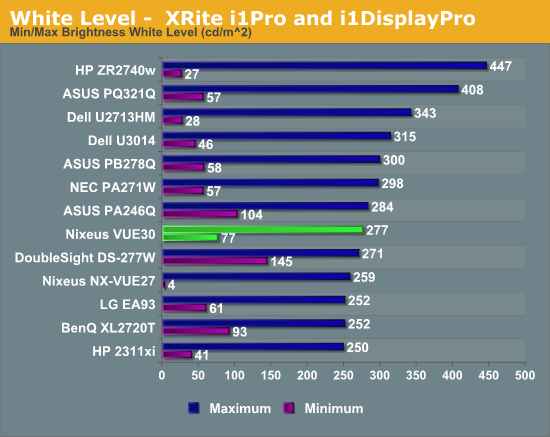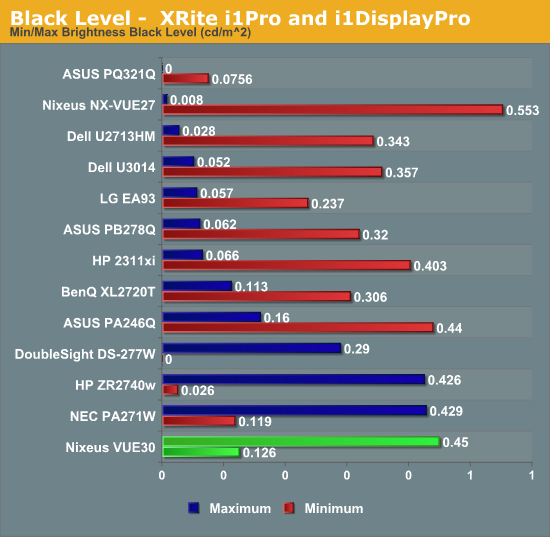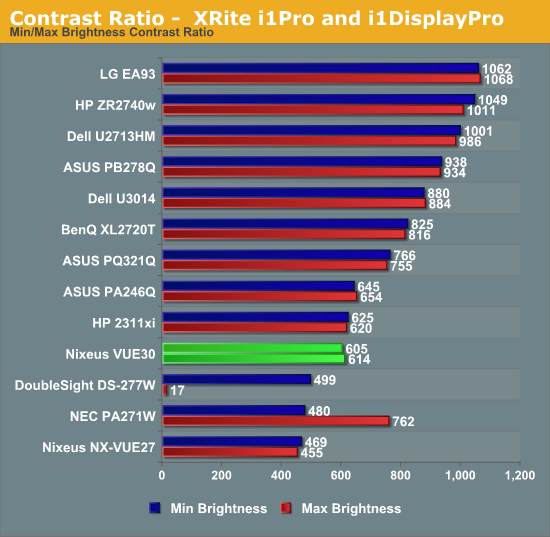Nixeus VUE 30: 30" 2560x1600 IPS Monitor Review
by Chris Heinonen on August 20, 2013 6:00 AM ESTIt seems that the larger the panel on a display I review, the brighter the display can get. I always expect the opposite, as lighting more screen would take more and more power. So far, that has not been the case. The VUE 30 is plenty bright, but not as blindingly bright as many other large displays. When I crank the brightness to maximum I measure 277 cd/m2 of brightness on a pure white screen. Moving the brightness to minimum drops this down to 77 cd/m2, which is below the 80 cd/m2 I like the minimum to fall under. This should provide plenty of range for most users.

With a black screen, we see a black level of 0.126 cd/m2 with the backlight at the minimum level. With the backlight to maximum this jumps up to 0.45 cd/m2. This level is very much in line with other computer monitors. I won’t fault Nixeus for this, but I’m always surprised at the level of black that is accepted with PC monitors that isn’t acceptable with TVs. Modern plasma displays can produce black levels of 0.006 cd/m2 under the same test conditions, and modern LCDs can hit 0.05 cd/m2 as well. I understand why plasma isn’t used for a PC display, but I’d like to see all vendors work on their black levels going forward. Basically, this panel seems similar to the 30" IPS displays we tested over five years ago; it's just half the price now.

These numbers provide us with a contrast ratio of just 610:1 on average. This falls well behind the Dell U3014 and ASUS PQ321Q displays, which are the most recently reviewed 30”+ displays I have data for. Those both cost a lot more, but being close to 600:1 is a disappointment to me.

With those basic measures out of the way, it was time to see how accurate the VUE 30 is.










95 Comments
View All Comments
Sabresiberian - Tuesday, August 20, 2013 - link
It is great to see prices drop this much, but the standard 30" screen still has a serious problem, in my eyes. .25mm dot pitch.Okay that isn't terrible; it's something I could live with. But the fact is, I can buy a 27" with much better dot pitch (.233mm) and spend a lot less money. I hate the 16:9, but it isn't as bad as .25mm for me in that large of a display, personally, so the trade-off means I'll go with spending less money to get something a bit closer to what I want.
Give me 16:10.
Give me at least (most?) .233mm dot pitch, - better certainly isn't an unreasonable thing to ask in this day and age.
Give me an IPS panel (or comparable, or, gasp even better!), preferably with a backlight solution that doesn't feel like a heat lamp shining on my face.
Give me accurate colors, a uniform display, screen surface that isn't too reflective OR to heavily anti-reflective, a thin bezel so I can put 3 of them side-by-side without big spaces between the displays..
Give me low lag.
Sell it to me for less than $600. Really, I think $500 isn't unreasonable, but I'll buy it at $600.
JarredWalton - Tuesday, August 20, 2013 - link
Windows still doesn't handle odd DPI all that well, though 8.1 may improve this. As someone who has used 30" LCDs for years now, I will tell you that I have no issues with the dot pitch, and in fact I often have to increase the magnification to read text comfortably. I think a dot pitch for desktop displays of around 0.28-0.30mm is actually better for most people past 30 years old. For businesses with 40+ year old employees, I have had many instances where I had to set their 1080p or 1920x1200 display to run at a lower resolution because the user complained that the text was too small.So, sorry to burst your bubble, but in the larger market of the world (e.g. people older than 25) having higher DPI is not actually all that important or even desirable. Not to mention, if you had a 4K 25" display, you need GPUs capable of driving that resolution at a reasonable level of performance. Just like the business world doesn't worry too much about high DPI displays, they're not interested in high performance GPUs for general computer use either.
josephandrews222 - Tuesday, August 20, 2013 - link
GREAT comment about dot pitch and age. I'd like to see an anandtech article about dot pitch that addresses this very topic...in detail.Impulses - Tuesday, August 20, 2013 - link
These displays aren't marketed at the business world either tho...stephenbrooks - Friday, August 23, 2013 - link
Right on with the dot pitch comment. I recently got to work on a 27" 1440p display and felt I had to set the Windows 7 UI & font scaling to 125% rather than 100% (I'm 29). The side-effect was that 125% looked kind of "Mac like" with high res fonts still the same size, whereas 100% was like trying to work at a scale designed for ultraportable laptops.seapeople - Saturday, August 24, 2013 - link
I call BS. My eyesight is TERRIBLE. I can't see the broadside of a barn if it was flying at me and mooing. But I have these wonderful things called glasses. It's not like glasses stop working when you get older. I currently am sitting about 24 inches from my 125 ppi laptop screen and I can still tell that the text is not nearly as clear as it could be (i.e., on the retina iPad). For example, > ... that's not a smooth, clean arrow, it's a blocky/fuzzy travesty that would look so much better with more pixels in it.menting - Tuesday, August 20, 2013 - link
Does this monitor use PWM for brightness?I wish more monitor reviews would cover this section as well, as I (and quite a few others) find PWM annoying and tiring to the eyes
mdrejhon - Wednesday, August 21, 2013 - link
You can test a monitor's PWM by using http://www.testufo.com/#test=blurtrailmdrejhon - Wednesday, August 21, 2013 - link
Oh, and when testing TestUFO, make sure to use the Chrome browser, and lower brightness to 0% to check for the PWM artifact.ezridah - Tuesday, August 20, 2013 - link
You should review the 4 different Monoprice monitors. They have 2 types at each size and the low end ones are significantly cheaper than this.